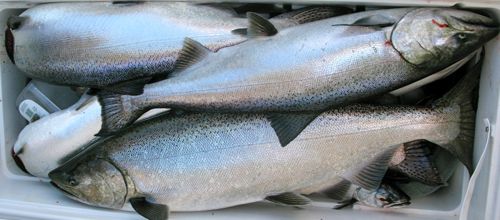
It wasn’t necessarily low abundance that prolonged the first opener of the season, but low expectations. Over 200 fewer boats than usual fished during the season, and some moved on to chum and coho when king fishing was inconsistent. (Flickr photo/Kegger)
Almost two weeks after it opened with mixed expectations, the first summer troll fishery for king salmon in Southeast Alaska is coming to an end.
The fishery closes officially at 11:59 p.m. Saturday, July 14. The Alaska Department of Fish & Game estimates that trollers will be close to their harvest target of 51,800 chinook by that time — and another opener in August appears likely.
Prior to the start of the season on July 1, many in the fleet expected the opener to especially short — maybe just 3 or 4 days — since the harvest target was so low.
But the low expectations may also have kept effort down. Management biologist Grant Hagerman says over 200 fewer boats fished in this year’s opener than in last. Many boats from California and Oregon remained to work the fisheries there, and some Alaskan trollers may have considered chum salmon a better bet this year. Kings were few and far between.
“And reports from the sport fishery on the outside were not good for May and June,” he said. “The catch rates were low, sport fishermen having difficulty getting even their one-fish bag limit. So that may have dissuaded the trollers somewhat.”
That pushed the catch rate down to about 3,700 fish a day total — about 13 kings per day average for every boat — and extended the season to almost two weeks.
While this isn’t exactly a windfall for the boats that stayed in the fishery this year, Hagerman says it’s comparable to other years when there has been low abundance.
A more significant issue was distribution: The bite was inconsistent, and the kings seemed to be farther offshore than usual, 5-20 miles, and beyond the range of many smaller boats.
“There were vessels that found kings, that had a good king opening, but for the most part trollers were frustrated that kings were not in the traditional fishing areas,” said Hagerman.
Trollers went into the season earning a record price for June — $12.50 a pound for the few spring fisheries that were open. As usual, prices dipped to $8 on the first day of the season early on, but ticked back up when the market realized that there wasn’t going to be a huge pulse of kings coming through the doors as in past years. Hagerman says the season average was $8.34 per pound.
Saturday’s closure doesn’t put an end to fishing for the year. Trollers are already targeting chum and coho salmon.
In fact, Hagerman says the coho picture is brighter than last year, with a good price, fish that are averaging a pound larger than typical for this time in the season, and fish that are available on the usual near-shore drags.
Things have not gone as badly as they could have.
“I’m happy to see that we’re going to reach our target, and to see cohos materialize over the last few days has been a nice change,” he said. “That was a bit of a concern. But those fish are there and things are starting to improve.”
By regulation, the summer troll season for kings is split 70-30 between July and August. That leaves roughly 22,000 chinook still to be caught. Although Fish & Game never re-opened king trolling last August — triggering year-long acrimony between the fleet and the Commissioner’s office — Hagerman says the additional pre-season cut to the harvest was meant to prevent any similar closure this year, and he expects an opener as usual in August.
The concerns over low chinook escapement in Southeast’s big river systems remain, however. Despite conservation measures last year, Hagerman says it looks like a number of “wild systems will not meet escapement goals.”






























